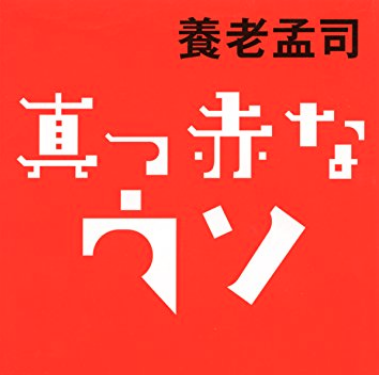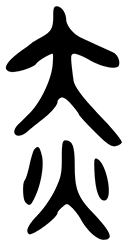155. The "Red" Radical: 赤
The "red" radical 赤 is on duty in only two Joyo kanji:
赤 (46: red)
赦 (1336: to pardon, forgive)
In the first case, we can call the radical あか, which matches one Joyo kun-yomi of the 赤 kanji itself. In the second case, when the 赤 radical slides to the left, the name あかへん works well.
This seven-stroke radical has no variants but clearly becomes thinner when on the left.

What a cool font! To find out about this title, read on.
Complete Lies
I associate red with blushing, lipstick, menstruation, the flag of Japan, and communism, as well as with "seeing red" (being furious). As for how the Japanese think about redness, check out the secondary definitions of this term:
真っ赤 (まっか: (1) bright red; deep red; flushed (of face); (2) downright (e.g., lie); complete; utter)
The set phrase 真っ赤な嘘 (まっかなうそ: complete lie; outright lie) constitutes the title of the book shown above, though ウソ has replaced the non-Joyo 嘘. It's quite common to use that katakana in this expression.
With this work, author Takeshi Yoro (an anatomist, physician, and critic) examines lies that people widely believe. He explores how these falsehoods work and what benefits they bring.
The following phrase reinforces the sense that 真っ赤 is strongly connected with lies:
真っ赤な偽物 (まっかなにせもの: fake objects)
It isn't just 真っ赤 that the Japanese associate with "downright; complete; utter." That's also true of 赤 in terms such as these:
赤の他人 (あかのたにん: complete stranger)
赤裸 (せきら or あかはだか: completely naked)
赤裸々な (せきららな: naked (truth))
赤恥 (あかはじ: utter humiliation) or 赤っ恥 (あかっぱじ: utter humiliation)
赤心 (せきしん: one’s true heart; good faith)
赤誠 (せきせい: true sincerity)
Etymologies
Let's see what 赤 contributes to each of the Joyo kanji in which it's on duty. Both etymological analyses below come from the newer edition of Henshall:
赤 (46: red)
Speaking of untrue things that many people believe, it's popularly thought that 赤 consists of "earth" (土) over "fire" (灬), but that's incorrect. Instead, scholars focus on old forms, such as this bronze-script version from Sears:

Such researchers interpret this as showing 大 (big) over 火 (fire), collectively meaning "fire burning brightly" and thus "red (flames)."
赦 (1336: to pardon, forgive)
This character combines 攵 (hit (with whip/stick)) with 赤 (red). The 赤 acts phonetically to convey the sense "cast aside," giving the overall meaning "cast aside the idea of whipping someone for their crime," which is to say "pardon, forgive."
I'm quite surprised that Henshall treats this latter instance of 赤 as the phonetic. As you know, Joy o' Kanji classifies 赦 under the 赤 radical. Kanjigen does, too, noting that 赤 is also the phonetic.
